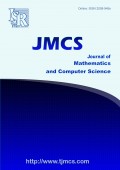Comparison Between Artificial Neural Network Learning Algorithms for Prediction of Student Average Considering Effective Factors in Learning and Educational Progress
-
3703
Downloads
-
5183
Views
Authors
Saeed Ayat
- Department of Computer Engineering and Information Technology, Payame Noor University, Iran.
Zabihollah Ahmad Pour
- Department of Science, Islamic Azad University – Ayatollah Amoli Branch, Iran.
Abstract
In this project, by using different learning algorithms in the form of 37 input parameters of
network for predicting average considering effective factors in learning and educational
progress, the Perceptron artificial neural network have been studied.
The requisite data have been obtained through handing out questionnaires between 400
students of Payame Noor University majoring in computer engineering, information
technology and computer science.
For recognizing the best learning algorithm, 13 common algorithms considering factors
such as training time, the percentage of accountability, the index of efficiency ( the mean
squared errors), and the number of epoch have been studied after error propagation. Finally
the LM algorithm was recognized as the best learning algorithm for prediction of average.
Share and Cite
ISRP Style
Saeed Ayat, Zabihollah Ahmad Pour, Comparison Between Artificial Neural Network Learning Algorithms for Prediction of Student Average Considering Effective Factors in Learning and Educational Progress, Journal of Mathematics and Computer Science, 8 (2014), no. 3, 215 - 225
AMA Style
Ayat Saeed, Pour Zabihollah Ahmad, Comparison Between Artificial Neural Network Learning Algorithms for Prediction of Student Average Considering Effective Factors in Learning and Educational Progress. J Math Comput SCI-JM. (2014); 8(3):215 - 225
Chicago/Turabian Style
Ayat, Saeed, Pour, Zabihollah Ahmad. "Comparison Between Artificial Neural Network Learning Algorithms for Prediction of Student Average Considering Effective Factors in Learning and Educational Progress." Journal of Mathematics and Computer Science, 8, no. 3 (2014): 215 - 225
Keywords
- learning algorithm
- artificial neural network
- MLP
- prediction of average.
MSC
References
-
[1]
M. R. Mustafa, R. Rezaur, S. Saiedi, M. He, River Suspended Sediment Prediction Using Various Multilayer Perceptron Neural Network Training Algorithms_A case Study Malaysia, Water Resour manage, 26 (2012), 1879-1897.
-
[2]
N. I. Daliakopoulos, P. Couliblay, H. K. Tsanis, Ground water level forcasting using artificial neural networks, J. Hydrol., 309 (2005), 229-240.
-
[3]
M. T. Hagan, H. B. Demuth, M. H. Beal, Neutral Network Design, PWS, Beston (2005)
-
[4]
B. D. Ripley, R. M. Reipley, Neural networks as statistical methods in survival analysis, Journal of statistics, (2006), 409-456.
-
[5]
G. L. Dee, N. Bakhary, A. Abdul Rahman, B. Hisham Ahmad, A Comparison of Artificial Neural Network Learning Algorithms for Vibration- Based Damage Detection, Journal of Advanced Materials Research, 163-167 (2011), 2756-60.
-
[6]
A. Fbrizzio, L. Edna, D. Christian, A. Gilberto, C. Antonio, V. Paschoarelli, Recursive diameter Prediction And Volume Calculation of Eucalyptus Trees Using Multilayer Perceptron Networks, Applied Soft Comuting, 12 (2012), 2030-2039.
-
[7]
H. Demuth, M. Beale, Neural Network Toolbox User's Guide , Copyright 1992-2002, By The Math Works. Inc., 4 (2000), 480
-
[8]
K. Abhishek, M. P. Singh, S. Ghosh, A. Anand, Weather Forecasting Model Using Artificial Neural Network, Procedia Technology, 4 (2012), 311-318.
-
[9]
A. Lakdashti, R. Yousedi, Kh. Khatiri , Effect of Simulated Education Software on Student Learining and Compare it With Traditional Method of Teaching, Journal of Information and communication technology in education, in Persian. , 3 (1390), 5-21
-
[10]
A. Akbari , Methods of Study, Faiz Kashani, in Persian. , Tehran (1382)
-
[11]
M. Parsa, Psychology of Learning, Fourth Edition, Payame Noor, in Persian. , Tehrn (1385)
-
[12]
S. Sattari, E. Jaafar Nezhad, Factors affecting the utilization of visual aids in the teaching - learning from the perspectives of teachers in Mazandaran, Journal of Information and communication technology in education, in Persian , 2 (1389), 6-20
-
[13]
E. Khalkhali, Z. Shakibaee, M. Andesh, Meta-analysis of the effects of ICT on professional development of teachers, Journal of Information and communication technology in education, in Persian. , 3 (1390), 165-183
-
[14]
M. Behrangi, Teaching models, Kamal Tarbiat, in Persian , Tehran (1387)
-
[15]
M. kantardzic, Data Mining: Concepts, Models, Methods and Algorithms, Second Edition, John Wiley (2011)
-
[16]
M. Akbari, A. Ranaee, H. Namaghi, Assessment of desertification sensitivity parameters using artificial neural network , Journal of Soil and Water (Agricultural Sciences and Technology), in Persian. , 25 (1390), 398-410
-
[17]
T. Sabzevari, R. Mohammad Pour, M. E. Zemorrodian, Evaluation parameters of earth dam failures using neural networks, First National Congress on Civil Engineering, , 12-14 May, in Persian, Sharif University (2003)
-
[18]
M. B. Menhaj, Foundations of Neural Networks , Vol. 1, Amir Kabir University, in Persian. , Tehran (1387)
-
[19]
S. Shokr Beygi, A. Afkari Sayyah, H. Shayeghi Moghanloo, E. Shokouhian, Effects of temperature and Cushioned surface on the apple contusion volume Created by Tension and Predict it using artificial neural network, Journal of Food Science and Technology, in Persian., 31 (1390), 85-94
-
[20]
A. Ali Pour, S. Kalantarian, The relationship between handedness with academic achievement of middle school students, Journal of School Psychology, in Persian, 1 (1391), 7-26

